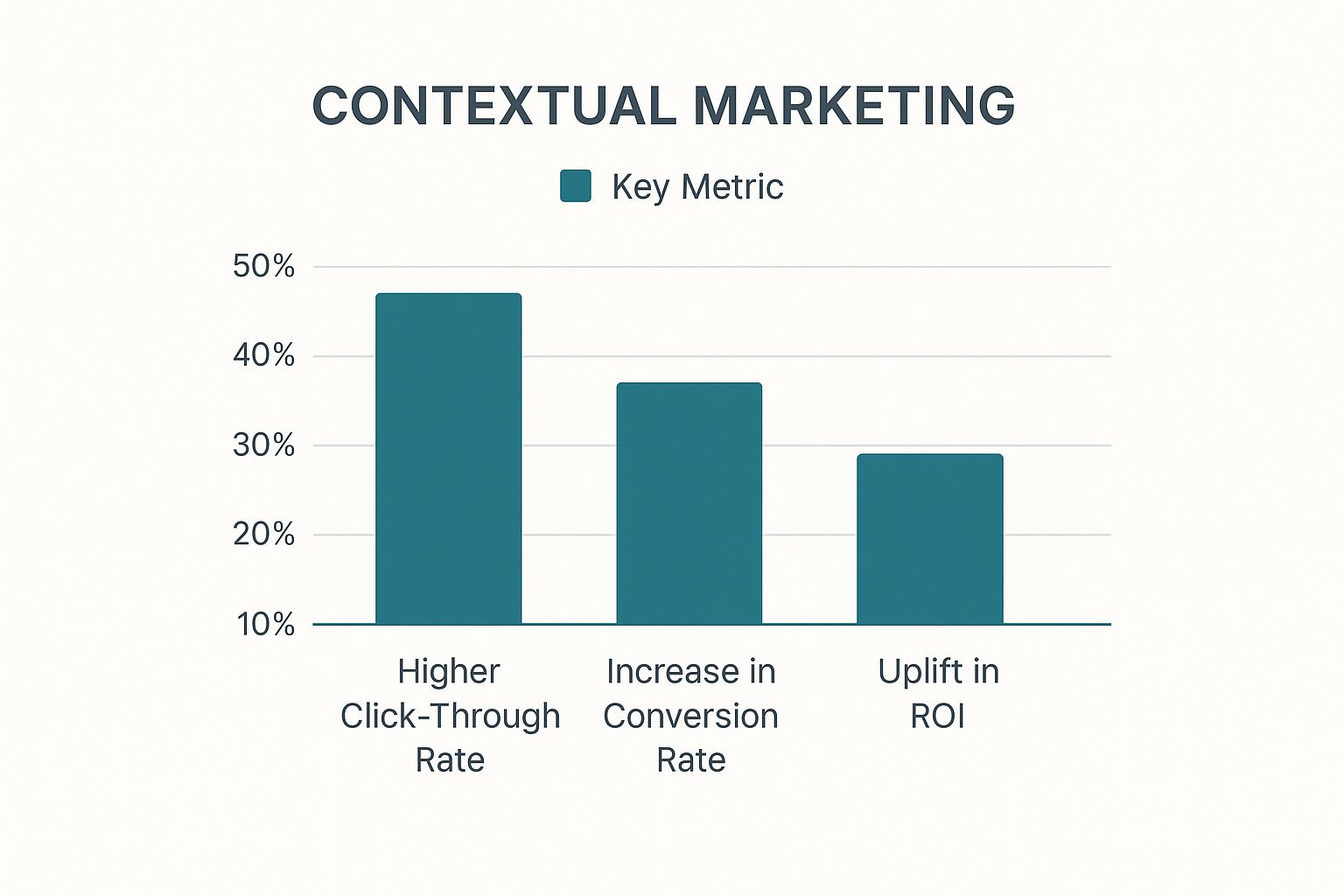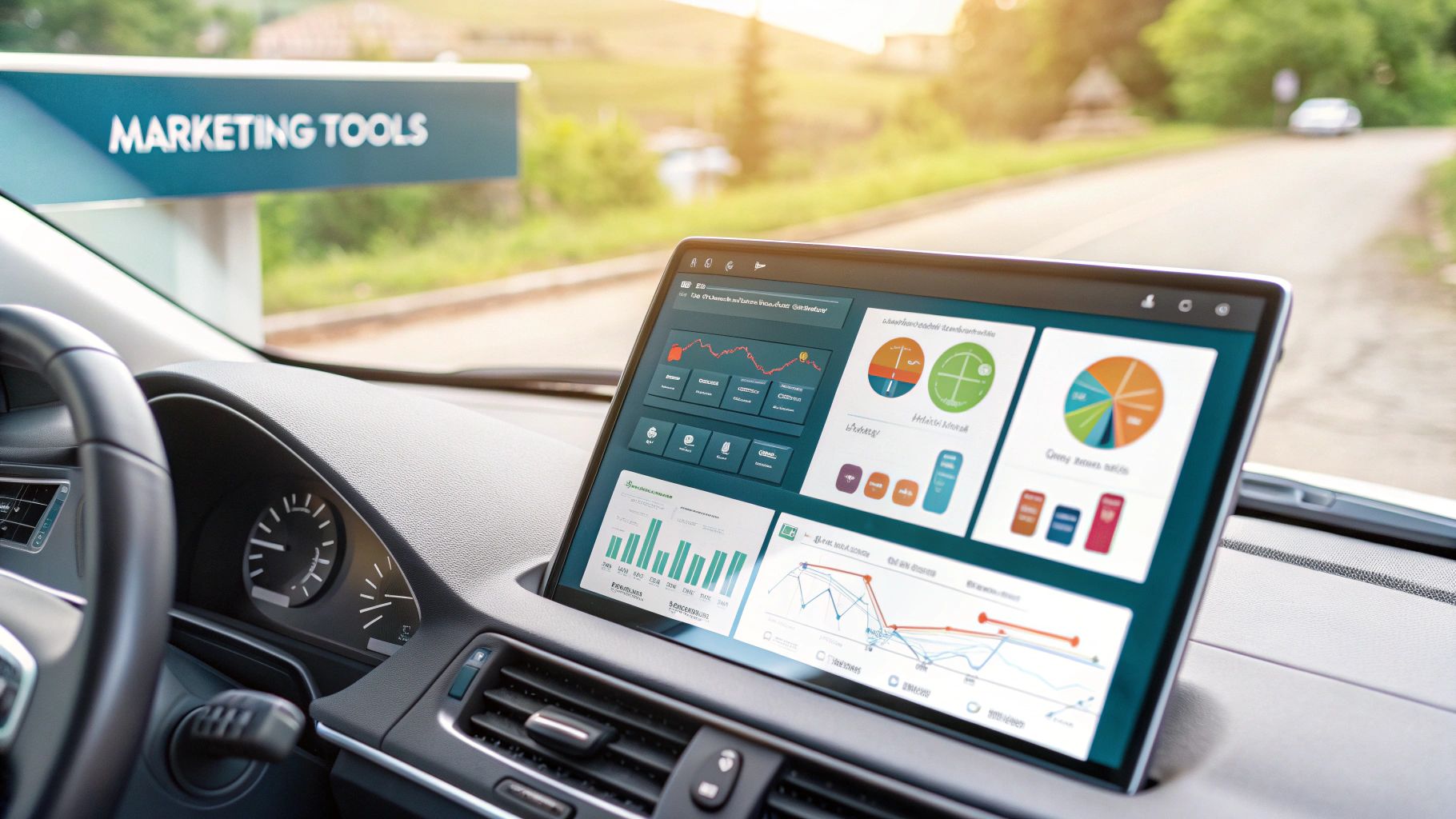
Forget chasing people around the internet with ads for things they looked at last week. Contextual marketing is simpler and smarter: show up with the right answer, in the right place, at the exact moment someone is asking the question.
Think of it this way: Behavioral marketing is the salesperson who saw you browse hiking boots a month ago and now follows you into a bookstore, shouting about shoe deals. It’s creepy and out of place.
Contextual marketing is the sign for an ice-cold drink you see right at the trailhead on a 90-degree day. It’s relevant, timely, and actually helpful.
The End of Guesswork Marketing Is Here
For years, marketing felt like shouting into a crowded room and hoping the right person heard you. That era is over. Today, you win by meeting customers exactly where they are—both physically and mentally.
This is the entire premise of contextual marketing. Instead of using third-party cookies to guess who someone is, you look at what they're doing right now. Are they reading an article titled "Best Alternatives to Zendesk"? Watching a YouTube tutorial on financial modeling? That immediate context is all you need to deliver a relevant message.
At BillyBuzz, we stopped obsessing over user history and started focusing on user intent. We shifted from asking, "Who is this person?" to "What problem are they trying to solve right now?" This simple change in perspective was a game-changer.
From Intrusion to Invitation
Traditional behavioral advertising has a reputation for being intrusive for a reason—it stalks you. An ad for a single product you clicked on once can haunt you across every site you visit for weeks. It’s an interruption.
Contextual marketing flips the script. It’s an invitation. Because it appears within a relevant environment, it feels less like an ad and more like a helpful suggestion. This isn't just a "nicer" way to advertise; it delivers dramatically better results.
When your message aligns with what’s already on a user's mind, they're far more likely to engage.

The numbers don't lie. When an offer fits seamlessly with the content someone is actively consuming, the clicks and conversions just naturally happen.
It turns out, people prefer this approach, too. A staggering 79% of consumers say they prefer contextual ads to behaviorally targeted ones. In fact, privacy-friendly ads can generate up to 50% more clicks. If you want to dive deeper, you can explore more about the power of contextual advertising and its proven metrics. It’s a win-win: customers get a better, more respectful experience, and brands get better results.
Contextual vs Behavioral Marketing at a Glance
To really understand the shift, it helps to see the two approaches side-by-side. One is rooted in the past, while the other thrives in the present moment.
| Attribute | Contextual Marketing | Behavioral Marketing |
|---|---|---|
| Data Source | Content of the current page (keywords, topics, sentiment) | User's historical browsing data, clicks, and purchases |
| Focus | "What is the user interested in right now?" | "Who is this user based on their past?" |
| Privacy Impact | Minimal; does not rely on personal identifiers or cookies | High; depends heavily on tracking users across sites |
| User Perception | Relevant, helpful, non-intrusive | Often seen as creepy, intrusive, and repetitive |
| Ad Placement | On pages with content directly related to the ad | Follows the user across unrelated websites |
Ultimately, contextual marketing respects user privacy and delivers relevance without being invasive, making it the clear winner in today's privacy-first world.
Why We Made Contextual Our Non-Negotiable Strategy

Here at BillyBuzz, we didn't just stumble into contextual marketing—we dove in headfirst. It wasn't a whim. It was a calculated move based on three undeniable advantages that completely shifted our thinking. For us, this is about building a healthy, sustainable brand, not just chasing quick wins with invasive data tactics.
First, the customer experience. Nobody likes feeling stalked across the internet by an ad for a pair of shoes they clicked on once. Contextual marketing eliminates that. It's helpful, not intrusive, because it respects what the user is focused on right now. This cuts down on ad fatigue and builds a sliver of trust.
Second, future-proofing. With privacy laws like GDPR and CCPA getting stricter and the third-party cookie finally crumbling, sticking to old-school behavioral targeting is like building on a shaky foundation. Contextual is our way of ensuring our outreach stays effective and compliant, no matter what changes come our way.
Better Experience, Better ROI
The final piece of the puzzle—and the one that really sealed the deal—is the return on investment. Our old behavioral ad campaigns were always a bit of a gamble, with results all over the place. Our contextual campaigns, on the other hand, paint a much more compelling picture.
By zeroing in on specific subreddits and niche forums where our ideal customers are already talking about the very problems we solve, the quality of our engagement went through the roof. We stopped being the annoying interruption and started being a welcome part of the conversation.
The bottom line? Our conversion rates from these contextual channels consistently blow our old programmatic ad spends out of the water. We're not just getting more clicks; we're sparking real conversations that turn into demos and, ultimately, loyal customers. It was definitive proof that when your message perfectly aligns with someone's immediate interest, the ROI just naturally follows.
The global shift toward this strategy is undeniable. The contextual marketing market was valued at USD 198.4 billion in 2024 and is projected to explode to USD 748.5 billion by 2034. This growth is a direct result of its power to deliver targeted, privacy-safe advertising in a post-cookie world. Discover more insights about the contextual advertising market's rapid growth.
The Power of Real-Time Relevancy
The secret weapon for us has been using AI to grasp context on a much deeper level. This isn't just about matching a few keywords anymore. It’s about understanding the sentiment, the nuance, and the true intent behind an online conversation before we even think about jumping in.
That’s where real relevancy is born—knowing the difference between a user just venting about a problem versus someone actively hunting for a solution. If you want to build a contextual strategy that actually works, you have to dig deeper than surface-level signals. Understanding the tech behind this is key, which is why we’ve detailed more on this in our guide to understanding AI-powered relevancy scoring in digital marketing. It's the engine that powers our entire non-negotiable strategy.
Our Real-World Contextual Marketing Playbook
Alright, enough theory. Let's pull back the curtain on the actual BillyBuzz playbook. This is exactly how we turn online chatter into customer relationships. No fluff, just the founder-to-founder blueprint you can use today. Our whole strategy is simple: listen carefully, engage helpfully.
The heart of our operation is real-time social listening, and our favorite playground is Reddit. We don't see Reddit as a place to drop links. We see it as a massive, public focus group where our ideal customers are openly talking about their biggest problems.
Setting Up Our Listening Posts
First, we figured out where our audience actually hangs out. We didn't guess. We looked for active communities where founders, marketers, and small business owners were asking for advice.
Our current goldmines are:
- r/saas: Ground zero. People discussing growth, churn, and the exact challenges our tool solves.
- r/smallbusiness: A great place to find operational headaches that small business owners face.
- r/marketing: Broader, but invaluable for spotting trends and finding people looking for new tools.
Once we picked our subreddits, we set up specific alert rules inside BillyBuzz. We're not just tracking our brand name—we're hunting for intent.
A huge mistake founders make is just tracking their brand name. The magic is finding people who have no idea you exist but desperately need what you sell. That’s what is contextual marketing in practice—finding the problem, not just waiting for a product mention.
Our alert rules flag conversations that signal buying intent. Here are a few we use right now:
- High Intent:
(looking for OR recommend OR alternative to OR tool for) AND (social listening OR reddit monitoring OR lead generation)inr/saas. - Problem-Aware:
(how to find OR struggling with OR tired of) AND (customers on reddit OR manual monitoring)inr/smallbusiness. - Competitor Trigger:
("mention: CompetitorX" OR "mention: CompetitorY") AND (pricing OR support OR difficult)in any of our target subreddits.
These alerts hit our team's Slack, letting us jump on a conversation the moment it happens.
Engaging Without the Sales Pitch
Getting the alert is half the job. How you engage separates being helpful from being spam. Our one rule: add value before you mention your product.
We use a simple response framework that we customize for every interaction. It’s not a script; it’s a mindset.
Our Value-First Response Template:
- Acknowledge & Empathize: Show you get their specific problem. "I've been there. Tracking conversations manually is a massive time sink."
- Offer a Genuine, Product-Agnostic Solution: Give a helpful tip they can use right away, even if they never become a customer. "One thing that helped us early on was setting up a few specific Google Alerts for key phrases combined with
site:reddit.com." - Introduce Your Solution Contextually: Only after providing value do you briefly mention your tool. "We ended up building BillyBuzz to automate this because it was eating up so much time. It basically does [X and Y] to solve [the problem]."
- No Hard Sell: End with a soft, no-pressure closing. "Happy to share more if you're curious, but hope the manual tip helps either way!"
This turns a cold interruption into a warm interaction. If you want to go deeper on using AI to nail your messaging, guides like this AI-driven content analysis playbook are a great next step.
Here’s a look at the kind of conversations we're constantly monitoring in r/saas.

This screenshot shows a typical feed where founders are talking about everything from MRR to churn—every single post is a potential opportunity to engage. It's an absolute goldmine of insights for any B2B company.
Real-World Contextual Marketing Examples We Live By
Theory is fine, but seeing it in action is what matters. Here are three contextual marketing plays we run at BillyBuzz every week. This is the engine that drives our growth.
Example 1: The Reddit Responder
Our social listening alerts are our secret weapon. The whole game is finding someone actively looking for a solution and showing up right when they need you.
The Context: A Slack alert fires. Someone in r/smallbusiness posted, "I'm losing my mind trying to manually track mentions of my competitors on Reddit. Is there an easier way to do this without spending hours searching every day?" A perfect layup.
The Message: We always lead with value. Our response started with empathy and a free tip: "Setting up a few hyper-specific Google Alerts using
site:reddit.comcan be a good starting point." After helping first, we gently introduced our tool: "We actually built BillyBuzz to solve this exact headache. It automates the monitoring and sends alerts to Slack."The Result: The original poster replied in the thread, thanked us for the tip, and asked for more info. That conversation moved to DMs, which led to a demo, and then a new paying customer. That’s contextual marketing—finding a problem and solving it on the spot.
Example 2: The Niche Blog Comment
We take the same "be helpful" approach to industry blogs. This isn't about link-building; it’s about positioning ourselves as experts where our ideal customers are already learning.
The Context: We spotted a popular marketing blog that published a killer article, "10 Ways to Find Your First Customers." The comment section was buzzing with early-stage founders—our people.
The Message: No link-dropping. We aimed to add genuine value to the conversation. Our comment read something like, "Great list! One strategy that worked wonders for us was actively monitoring niche forums for problem-based keywords. The conversations are a goldmine." It fit the article's topic perfectly. Our profile name and linked website did the rest.
The Result: Months later, that one comment still sends us high-quality referral traffic. We can see it in our analytics—people see our helpful comment, get curious, and click through.
Example 3: The Hyper-Targeted Ad
Even our paid advertising is built around context, not cookies. This lets us run small, incredibly efficient campaigns.
Placing ads based on a user's immediate interest can increase purchase intent by as much as 63%. It's not just less intrusive; it's far more effective at driving action.
The Context: We found a tech review site with a popular, high-ranking article comparing five different project management tools. It’s safe to say anyone reading that article is deep in a buying cycle.
The Message: We ran a simple display ad with a headline that spoke directly to their problem: "Tired of Juggling Tools? Monitor Customer Conversations Instead." We configured the ad to only show up on that specific article and a few others in the "project management software" category.
The Result: The ad’s click-through rate was over 4x higher than our old, behaviorally targeted campaigns. We spent less money to reach a better audience because we targeted the content they were consuming, not their past browsing history.
AI Is Reshaping The Future Of Context

If you think contextual marketing is just keyword matching, it's time to look again. The future is all about a deep, almost human-like understanding of content, powered by AI. We're moving from simply spotting words to gaining true situational awareness.
This shift means technology can finally grasp nuance. An AI can now tell the difference between an article celebrating a new piece of software versus one tearing it apart for its flaws. For a founder, that's a game-changer. It means your brand shows up in positive, safe environments that actually align with your values, not just next to a random keyword mention.
Here at BillyBuzz, we’re already leaning into these advanced signals. It's no longer enough to know someone mentioned a "project management tool." We need to know why they mentioned it.
Moving To True Situational Awareness
We've started integrating sentiment analysis to make our alerts smarter. This simple step helps us see the difference between a user enthusiastically recommending a competitor and someone venting their frustration while looking for an alternative. One is a moment to watch from the sidelines; the other is a golden opportunity to jump in and help.
This is where the real magic happens. We're seeing a clear move away from broad, keyword-based tactics and toward this kind of sophisticated semantic analysis. The rise of generative AI is only speeding things up, making contextual marketing a must-have for any modern strategy.
The next frontier isn't just finding the right conversation; it's about crafting the perfect response at scale. This is where generative AI becomes an incredible co-pilot for a small team.
We use generative AI to help our team draft value-first responses in a fraction of the time. It’s not about automating conversations and sounding like a robot. It’s about making us better and faster at being human. An AI can summarize a long, complex thread and suggest a few genuinely helpful talking points, letting our team personalize a thoughtful reply in seconds, not minutes.
As AI continues to evolve, new ideas like Generative Engine Optimization are giving us a peek into what’s next for context-aware content.
Ultimately, these tools are making contextual marketing smarter, faster, and surprisingly, more human. To see how we’re putting this into practice, we wrote a post detailing how AI transforms contextual analysis in media monitoring.
Common Questions About Contextual Marketing
Even as founders get excited about this strategy, a few practical questions always pop up. We get it—we had the same ones when we first started. Here are the most common questions we hear, along with the straight-up, actionable answers we've learned from building BillyBuzz.
How Do I Start With Contextual Marketing On a Small Budget?
You don't need a massive budget or a suite of expensive tools to get started. In fact, the best way to begin is by doing things manually.
Find 5-10 online communities where your ideal customers are already hanging out. Think niche subreddits, specific forums, or focused LinkedIn groups. Just set aside 30 minutes a day to read through the conversations. When you spot a problem you can genuinely solve, jump in with helpful advice—no hard sales pitch necessary.
At BillyBuzz, our first move was to track three subreddits and set up free Google Alerts for keywords related to the problems we solve. This zero-cost approach landed us our first 10 customers. The secret sauce is consistency and a "give first, ask later" attitude. Once you've proven the channels work, then you can think about investing in an affordable tool to scale up.
Is Contextual Marketing Only For B2B Companies?
Not at all. The fundamental idea of meeting customers in their moment of need works for everyone.
Think about a B2C brand that sells running shoes. For them, contextual marketing could be placing an ad on an article reviewing "the best marathon running gear" or sponsoring a YouTube channel that's all about trail running. A local coffee shop could run ads targeting people in their neighborhood who are searching for "coffee shops near me."
The context just shifts from a business problem to a personal want or interest. The strategy is exactly the same: be there with a relevant solution right when and where someone is looking for it.
How Do You Measure the ROI of Contextual Marketing?
Measuring your return on investment really depends on the channel you're using. If you're running direct contextual ads, the ROI is simple to track—you look at clicks, conversions, and cost-per-acquisition, just like any other ad campaign.
But for community engagement, like our work on Reddit, we track "softer" metrics that lead directly to hard ROI. Here’s how we do it:
- Unique Tracking Links: We put custom URLs in our team’s profiles. This lets us see exactly how much referral traffic we're driving from our community involvement.
- Conversation-to-Demo Rate: We keep a close eye on how many of those helpful conversations turn into scheduled product demos.
- Direct Feedback: We make it a point to ask new signups, "How did you hear about us?" You'd be surprised how often the answer is, "I saw your helpful comment on Reddit."
Over time, you can tie a clear pipeline value to these activities. It allows you to prove their direct contribution to revenue, turning what might feel like a "soft" marketing effort into a measurable growth engine.
Ready to stop guessing and start engaging with customers who are actively looking for a solution like yours? BillyBuzz is your AI-powered engine for finding and winning customers on Reddit. Sign up today and find your next customer.
